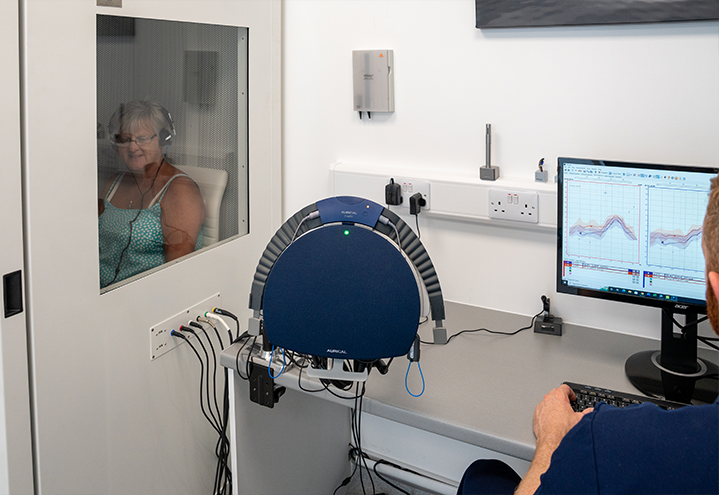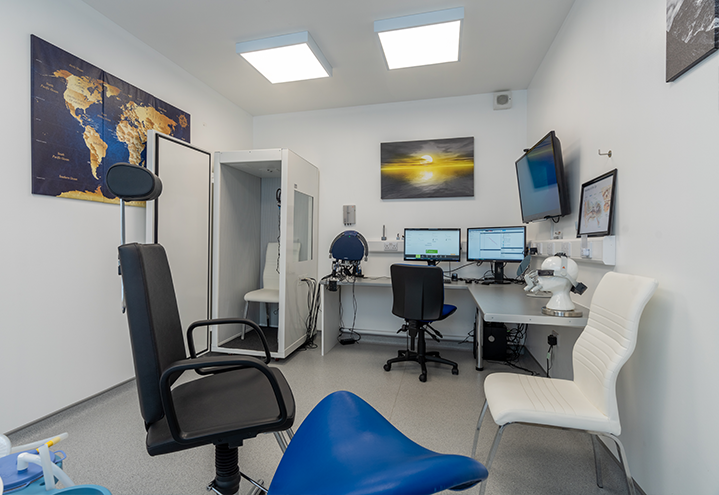Hearing Consultation Process
When you arrive for your hearing test, an audiologist will explain what to expect throughout the visit. Your audiologist will first check your ears for any physical blockages (typically, ear wax) that would affect hearing and the test results.
You’ll also be asked some questions about your hearing. These will likely include whether you’ve had any injuries or illnesses affecting your ears, whether you’ve had a history of auditory trauma (sustained loud volumes), and when you first noticed difficulties hearing.
Next is the test itself, called an audiogram. You’ll wear a set of headphones for somewhere between 20 – 25 minutes. The Audiologist will play a sequence of sounds, and you’ll indicate by pressing a button when you believe you’ve heard a sound. In most cases, this test is done one ear at a time, since hearing loss can occur at different levels in either ear.
The audiologist is measuring two things with this test: which frequencies you can or can’t hear (e.g., are high, middle or low pitches problematic for you?) and at what volume sounds have to be for you to hear them. These measurements are compared against a normal hearing pattern to establish the scope of your hearing loss.


If your audiogram reveals some hearing loss, your audiologist may add additional testing, such as a speech testing, to further analyse which spoken sounds are problematic for you.
Once additional testing is completed (if needed), your audiologist will outline a treatment plan for you. Expect to learn about the various hearing aids that could improve your hearing ability, as well as what the calibration and rehab processes look like.
Hearing Tests Below:
This test is carried out in a similar way to a Pure Tone Audiometry test except higher frequency tones are played. It is used to detect the early stages of high-frequency hearing loss associated with noise exposure. This test is important as early diagnosis of noise-induced hearing loss can help to prevent the progression of hearing loss, especially in speech frequencies.
This test is performed by playing pure tones of varying decibel levels into your ear through an earphone. Each ear will be tested individually and you will be asked to signal when you can hear a tone. The tones represent the important range of human hearing and help to establish what level of sound you can hear overall.
You may also be asked to take a bone conduction test. This test is used to determine the nature of the hearing loss you are experiencing. A small vibrator is placed on the mastoid bone behind the ear, which allows sounds to travel straight to the inner ear (bypassing the outer and middle ear) before travelling up to the brain. This allows the audiologist to establish whether your hearing loss in conductive or sensorineural.
This test simulates real-world listening situations to examine how well you can understand speech in a noisy environment, which can not be reliably predicted using other tests. Speech in Noise Testing addresses the most common complaint amongst hearing loss sufferers, which is not being able to enjoy social situations due to not being able to hear other people speaking when background noise is present.
During this test, the audiologist will recite a series of words or sentences and ask you to repeat them as the level of background noise gradually increases. The results will establish how your ability to understand speech is affected by the presence of background noise, which will allow specific treatment recommendations to be made.
HEARING AID SPECIALISTS IN DUMFRIES & GALLOWAY
We are the only independent hearing aid specialists based in Dumfries and Galloway.
Come and discuss your Hearing concerns in our Dumfries Practice with professionals who care. Alternatively follow the link to our contact us online form.
Give us a call on Tel: 01387 262781
About Us
As independent Hearing Aid Audiologists, we can provide you with hearing assessments and unbiased information on what hearing aid best suits your needs.
